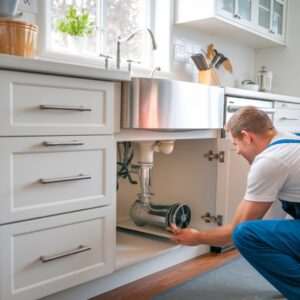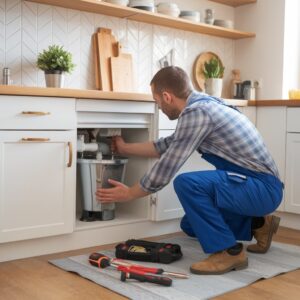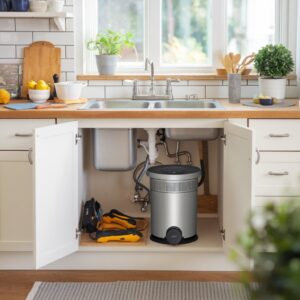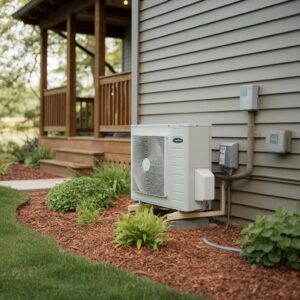To install a backflow preventer, first guarantee the relief valve and existing valves are accessible and functional. Prepare the plumbing system for compatibility. Plan unions on both sides for maintenance ease then cut the water line at the marked site. Securely fit the backflow preventer, guaranteeing watertight connections, and position it 12 inches above ground for accessibility. Finally, the installation will be tested for functionality and compliance. There’s more to discover for successful installation.
Key Takeaways
- Verify the accessibility and functionality of relief and existing valves before installation.
- Ensure the plumbing system is compatible with the new backflow preventer device.
- Install unions on both sides of the preventer for easy maintenance access.
- Position the assembly at least 12 inches above ground in an accessible area.
- Conduct thorough testing post-installation to confirm the device’s functionality and safety compliance.
Why Do You Need a Backflow Preventer?
Backflow occurs when water flows in the reverse direction, introducing contaminants into the clean water supply, which poses significant health risks.
A backflow preventer serves as a critical safeguard by ensuring that potable water remains uncontaminated, effectively maintaining water quality.
It is essential to install a backflow prevention device in situations where cross-connections between potable and non-potable water systems exist, such as in irrigation systems and industrial facilities.

What is Backflow, and Why is it a Problem?
Water contamination poses a significant risk to public health, making the prevention of backflow a critical concern in plumbing systems.
Backflow occurs when contaminated water reverses its flow, entering the potable water supply. This reversal can introduce harmful substances into the water system, compromising the quality of clean water.
A backflow preventer is an essential device designed to mitigate this issue and guarantee backflow prevention. It acts as a barrier, stopping contaminated water from infiltrating the potable water lines.
Without proper backflow prevention, the risk of backflow increases, leading to potential health hazards. Implementing effective backflow prevention measures is crucial to maintaining a safe water supply and protecting communities from the adverse effects of contamination.
Understanding the Role of a Backflow Preventer in Protecting Your Water Quality
The integrity of a potable water supply hinges on safeguarding it from contamination sources, a task that falls considerably on the function of a backflow preventer.
This essential backflow prevention device is designed to maintain water quality by ensuring that contaminated water from flowing back into the plumbing system is effectively stopped.
In environments where pressure fluctuations may cause reverse flow, the backflow preventer acts as a barrier, protecting the potable water supply from pollutants.
Its role is critical in preventing backflow, thereby ensuring clean drinking water and maintaining the overall health of the plumbing system.
When Should You Install a Backflow Prevention Device?
In what situations is the installation of a backflow prevention device essential? The necessity arises primarily to safeguard your water supply and guarantee public health.
A backflow preventer should be installed in the following scenarios:
- Municipal Water Supply: When properties are connected to a municipal water supply, there is a critical need to prevent water from flowing back into the public water supply, potentially contaminating it.
- Irrigation Systems: An irrigation system that connects to a potable water supply line can introduce contaminants. Installing a backflow prevention device is essential here.
- Plumbing Services: During plumbing services involving cross-connections or pressure differences, backflow prevention device installation is required to maintain the integrity of the water supply line.
These measures guarantee compliance with water utility standards and prevent contamination risks.
Choosing the Right Backflow Preventer for Your Installation
Selecting an appropriate backflow preventer requires an understanding of the different types of devices available, such as reduced pressure zone assemblies, double check valves, and pressure vacuum breakers.
The specific needs of a water supply system must be assessed, taking into account factors such as water pressure, potential contamination risks, and local regulations.
Evaluating these considerations guarantees the chosen backflow preventer will effectively safeguard the water system against contamination and comply with relevant standards.
Types of Backflow Prevention Devices Available
Choosing the appropriate backflow prevention device is vital for guaranteeing the safety and efficiency of any water supply system.
Multiple backflow prevention devices are available, each suited for specific situations to prevent contaminated water from compromising drinking water.
Key options include:
- Reduced Pressure Zone (RPZ) Assemblies: Ideal for high-risk installations where the water source may come into contact with chemicals or pollutants. RPZ assemblies guarantee the ultimate safety of your water supply.
- Double Check Valve Assemblies: Suitable for medium-risk environments. These assemblies are designed to prevent backflow in situations where the contamination risk is moderate.
- Pressure Vacuum Breakers (PVB): Best for installations requiring protection against back-siphonage, particularly when watering systems are connected to the main water supply.
Selecting the right backflow preventer is vital for safeguarding drinking water.
How to Determine the Backflow Preventer Needs for Your Water Supply
Effectively determining the backflow preventer needs for a water supply system requires a clear assessment of the installation’s specific conditions and risks.
The critical factors include the water line configuration, main water supply characteristics, and existing water pressure levels.
Identifying the types of backflow—whether back siphonage or back pressure—is essential for selecting the appropriate backflow prevention device.
The aim is to prevent water from flowing back into the system, thereby avoiding contaminated water from being brought back into the clean supply.
A suitable backflow prevention system should match the water meter specifications and meet the demands of the installation environment.
This guarantees that the backflow preventer valve installation is both efficient and effective, safeguarding the integrity of the water supply.

What to Consider When Selecting a Backflow Preventer
When considering how best to select a backflow preventer, it is vital to evaluate the specific requirements and constraints of the installation environment.
The selection involves understanding the types of backflow prevention devices, such as check valves, pressure vacuum breakers, and reduced pressure zone assemblies. Proper choice guarantees effective prevention of contamination through the water system.
Key considerations include:
- Installation Process: Assess the complexity of the installation process and determine what fittings would I need for the chosen device.
- System Pressure: Evaluate the water system’s pressure levels to select a suitable valve that can withstand operational stresses.
- Regulatory Compliance: Confirm the backflow preventer complies with local regulations and standards, which may dictate specific device types for certain applications.
Selecting the right preventer is vital for system integrity.
Step-by-Step Guide to Install a Backflow Prevention Device
Installing a backflow prevention device requires a systematic approach, beginning with the preparation of the plumbing system to ascertain compatibility with the new equipment.
The process involves securing the preventer onto the water line with precision to maintain system integrity.
Finally, verifying the correct installation and functionality through testing procedures is essential to confirm reliable operation and compliance with safety standards.
Preparing Your Plumbing System for Installation
Before starting the installation of a backflow prevention device, evaluating the existing plumbing system’s layout and condition is essential. This guarantees the backflow prevention assembly is effectively integrated to protect the clean water supply.
Key steps include:
- Inspect the Plumbing System: Examine the main water line to identify where the backflow preventer installation will occur. Verify the relief valve and any existing valves used are accessible and functional.
- Plan for Unions: To facilitate future maintenance, plan to install unions on either side of the backflow preventer. This allows for easy removal and inspection without disrupting the water flow.
- Verify Water Flow Direction: Confirm the correct direction of water flow to align the backflow preventer ensures maximum performance and compliance with safety standards.
How to Install a Backflow Preventer on Your Water Line
After assessing the plumbing system’s readiness, the next phase involves the precise installation of the backflow preventer on the water line. This task requires exactitude to guarantee the backflow prevention device functions at peak efficiency.
First, the plumber will identify the appropriate location on the water line, typically where the system connects to a public water supply. Here, the backflow assemblies are vital in preventing the flow of contaminated water back.
After marking the installation site, the plumber will cut the water line and securely fit the backflow preventer, making sure all connections are watertight.
For systems such as irrigation or sprinkler systems, having a backflow preventer installed is fundamental to prevent water from flowing back into the main supply, safeguarding against contamination.
Ensuring Correct Installation and Functionality
To guarantee the correct installation and functionality of a backflow prevention device, it is critical to follow a systematic approach.
The backflow preventer needs to installed at least 12 inches above ground level to guarantee proper water flow and functionality. The assembly should be installed inside an accessible area to facilitate maintenance.
Here is a step-by-step guide:
- Install the Device: Position the backflow prevention assembly at the specified height, verifying all connections are secure to safeguard against leaks.
- Check Alignment: Verify the alignment of the components to confirm the backflow preventer achieves peak performance and prevents water contamination.
- Test the System: Conduct a thorough test of the system after installation to confirm the device functions correctly and the water flows without obstruction.
Common Backflow Prevention Issues and How to Solve Them
In addressing common backflow prevention issues, it is crucial to identify installation errors, such as incorrect valve orientation or improperly sealed connections, which may compromise system integrity.
Regular maintenance, including cleaning debris and testing pressure differentials, guarantees the peak performance of backflow prevention devices.
When advanced complications arise, consulting a certified professional is advisable to prevent potential contamination risks.
Troubleshooting Backflow Preventer Installation Problems
Encountering issues during the installation of a backflow preventer can be a common challenge, even for experienced technicians. Proper troubleshooting guarantees that problems do not compromise the plumbing system’s integrity.
When technicians install a backflow preventer in irrigation or municipal water systems, they may face several challenges with the preventer valve and water main connections. Here are three common issues and solutions:
- Incorrect Valve Orientation: Confirm the preventer valve is aligned according to the flow direction indicated. Misalignment can cause improper functioning.
- Leaks at Connection Points: Check all fittings and seals for tightness and integrity. Replace worn or faulty components.
- Pressure Fluctuations: Verify that the installed system maintains consistent pressure. Adjust valve settings to stabilize water flow.
Maintaining Your Backflow Prevention System for Optimal Performance
Guaranteeing the ideal performance of a backflow prevention system requires meticulous maintenance practices to prevent common issues from compromising water safety. Regular inspection of the backflow prevention device is essential. Install backflow preventers at least 12 inches above ground to avoid contamination. A new backflow preventer should be inspected periodically, especially if used for backflow in systems like water heaters or fire protection. The valve keeps contamination at bay, but sediment can cause malfunctions. It’s important to check that the irrigation company correctly installs and maintains these devices.
| Common Issue | Solution | Maintenance Tip |
|---|---|---|
| Sediment Buildup | Regular Flushing | Schedule quarterly inspections |
| Incorrect Installation | Reinstall as needed | Confirm at least 12 inches height |
| Valve Malfunction | Replace faulty components | Check valve operation regularly |
When to Seek Professional Help for Backflow Prevention Issues
How often should one seek professional intervention for backflow prevention issues? Engaging expert plumbers is recommended when installation issues arise, guaranteeing compliance with plumbing regulations and safeguarding municipal water systems.
Professional help is vital to prevent contamination and maintain system integrity. Consider seeking expert intervention in the following scenarios:
- Valve Installation Complications: If the valve installation is improperly executed, it can fail to prevent backflow effectively. Professional assessment assures correct setup.
- Unidentified Leaks or Blockages: Should leaks or blockages be suspected, plumbing experts are essential to diagnose and rectify the problem without compromising the system.
- Regular Inspections: To guarantee continuous protection, periodic inspections by an expert plumber are advisable, as they can detect issues before they escalate, ensuring ideal backflow prevention.
Understanding the Role of a Backflow Preventer in Protecting Your Water Quality
A backflow preventer is a critical component in maintaining water quality by effectively blocking the reverse flow of contaminants into the potable water supply.
Its function is paramount in safeguarding public health, as it prevents potential exposure to harmful substances and pathogens.
Proper installation is essential to verify this device operates correctly, thereby guaranteeing the delivery of clean, safe water.
How Backflow Prevention Protects Against Contamination
Backflow prevention plays a critical role in safeguarding water quality by guaranteeing contaminants do not reverse flow into the clean water supply.
To protect municipal water from contamination, a backflow prevention device must be installed. This device acts as a safeguard, preventing pollutants from flowing back into the municipal water system. The installation of a backflow preventer valve guarantees that water flows in the intended direction, thereby maintaining the integrity of the water supply.
Key aspects of backflow prevention include:
- Installation Process: Properly plumb and install a backflow preventer valve to effectively allow water to flow in one direction.
- Contamination Prevention: Devices must be installed correctly to prevent backflow into the municipal water supply.
- System Integrity: Guarantees consistent water quality by obstructing potential contamination sources.
The Connection Between Backflow Prevention and Public Health
While often overlooked, the relationship between backflow prevention and public health is pivotal in ensuring safe water quality. A backflow preventer to safeguard against contamination is essential, especially when considering how to install backflow preventer valve systems properly.
These devices are typically installed in a vault, strategically positioned to prevent contamination. When users want to install such systems, they must also install additional components, like pressure gauges, to monitor effectiveness.
The correct installation process requires an understanding of which side of the valve is critical to blow out the system effectively, highlighting the need for a backflow expert. A detailed guide will walk users through installation steps, ensuring that public health remains uncompromised by poor water quality and potential contaminants.
Ensuring Clean Water with a Properly Installed Backflow Preventer
Proper installation of a backflow preventer is critical to maintaining clean water supply integrity, particularly in systems susceptible to contamination.
These devices function by preventing contaminated water from flowing back into the clean water supply, thereby safeguarding public health.
The effectiveness of a backflow preventer hinges on three essential factors:
- Correct Sizing and Selection: The device must match the specific requirements of the plumbing system, guaranteeing minimal disruption while maximizing protection.
- Professional Installation: A certified professional should install the device to guarantee adherence to all regulatory standards and manufacturer specifications, minimizing the risk of failure.
- Regular Maintenance: Routine inspections and maintenance are necessary to detect potential issues early, assuring the device remains effective over time.
These steps collectively guarantee water quality is consistently protected.
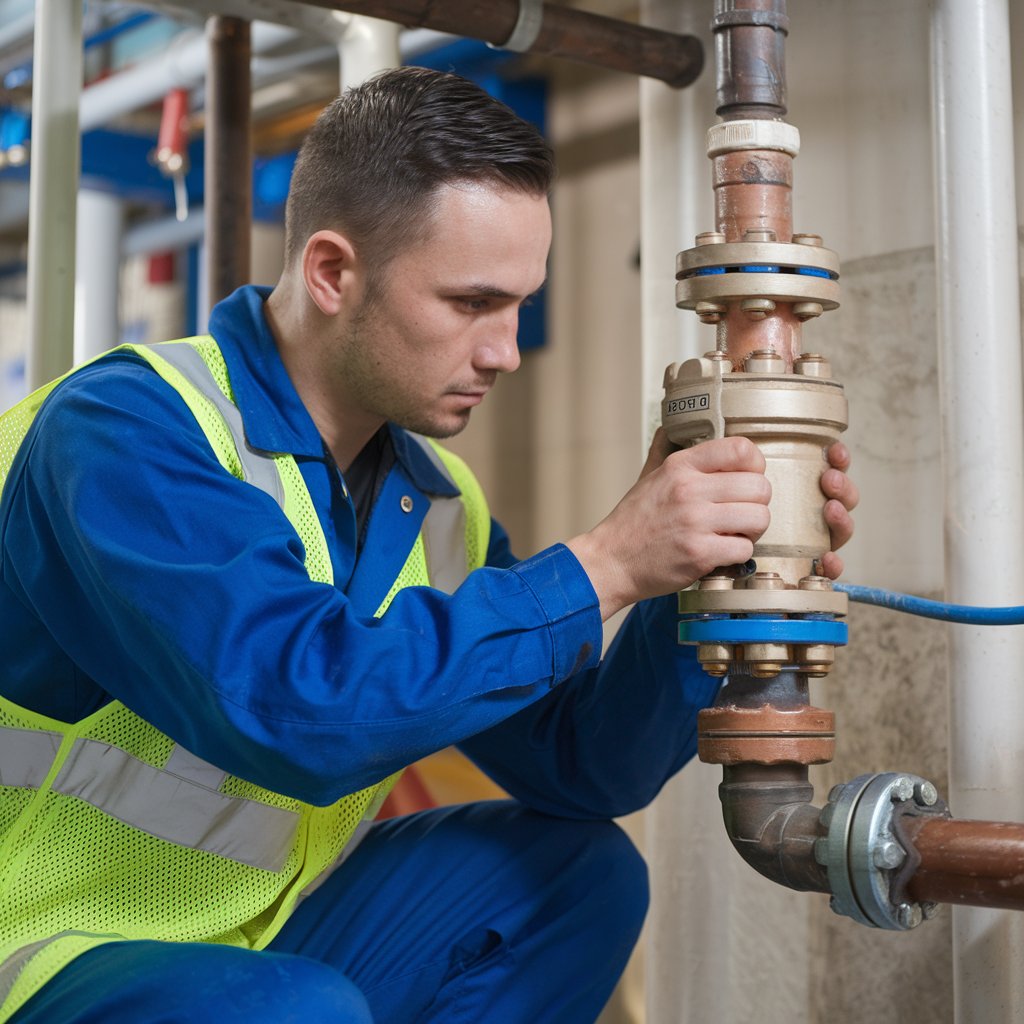
Conclusion
In summary, installing a backflow preventer is essential for maintaining water quality and protecting public health. By carefully selecting the appropriate device and following a systematic installation process, homeowners and professionals can effectively safeguard against potential contamination. Addressing common issues with informed troubleshooting guarantees the longevity and reliability of the system. Ultimately, a well-installed backflow prevention device serves as a vital component in preserving water integrity and preventing hazardous backflow incidents, underscoring its indispensable role in modern plumbing systems.

